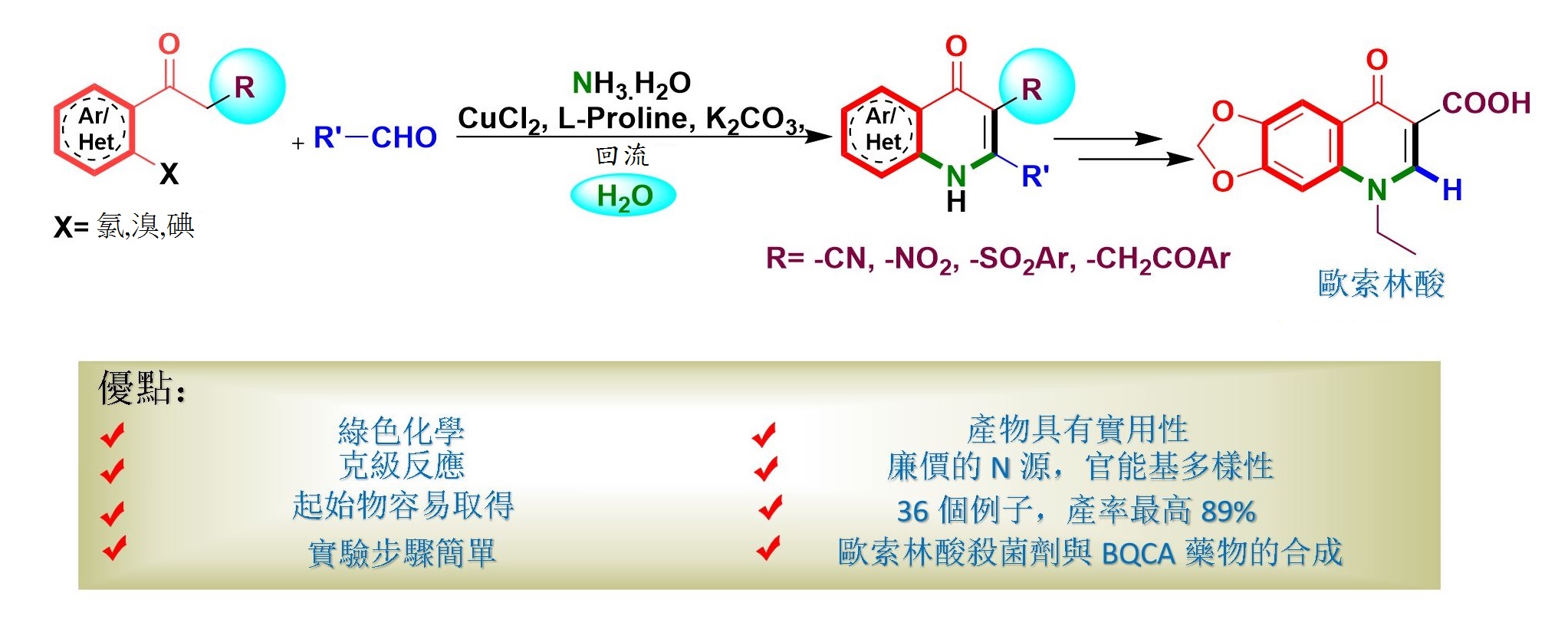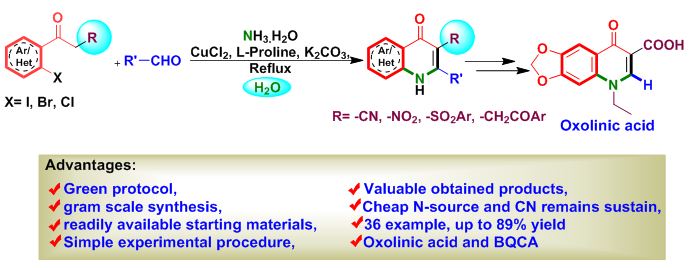使用水作為良性反應介質的銅催化合成4-喹諾酮類的合成
使用水作為良性反應介質的銅催化合成4-喹諾酮類的合成
在最近的研究中,高雄醫學大學開發了三組分合成且對環境無害的銅催化方法,對於取代的4-喹諾酮衍生物製備效果很好。研究人員開發了一系列4-喹諾酮類藥物的合成方法,並且成功應用於歐索林酸 (Oxolinic acid)殺菌劑與BQCA藥物的合成。由於以往的合成方法有些缺點,限制了它們的適用性,王志鉦教授的團隊發表以三組分:氨水、3-(2-鹵代苯基)-3-氧代丙烷、醛類在銅催化下,一步合成4-喹諾酮衍生物。這各方法具有應用價值且對環境無害。研究人員也進行了克級反應和藥物合成應用,證明了該方法的實用性。此外,其它取代基例如-CN,-NO2,-SO2Ar,-COAr和雜環化合物與甲醛的反應也可順利進行反應,其廣泛性也獲得證實。

本篇為高雄醫學大學2019年月傑出論文7月份得獎文章,代表作者為醫藥暨應用化學系王志鉦教授。這項工作的主要作者為Babasaheb Sopan Gore (博士生),李建中 (碩士生),李芷怡(大學生)與通訊為作者王志鉦(高雄醫學大學醫藥暨應用化學系教授)。
這項工作於2019年4月1日發表在《高級合成與催化》上(Adv. Syn. & Cat. 2019, 361, p3373-3386)。文章的全名是“使用水作為良性反應介質的銅催化合成4-喹諾酮類的合成,可在以下網站在線獲取https://onlinelibrary.wiley.com/doi/epdf/10.1002/adsc.201900286.
聯絡信息:
台灣高雄市三民區十全一路100號
高雄醫學大學醫藥暨應用化學系王志鉦教授
電話:(886)-7-3121101 傳真:(886)-7-3125339,
電子郵件:jjwang@kmu.edu.tw
高雄醫科大學博士後研究員Babasaheb Sopan Gore博士
電話:(886)- 68930195,電子郵件:gorepranav99@gmail.com
Application for the Construction of Oxolinic Acid and BQCA
Application for the Construction of Oxolinic Acid and BQCA
A copper-catalyzed three-component environmentally benign synthetic method has been developed for the synthesis of substituted 4-quinolone derivatives. In recent study, the researchers at Kaohsiung Medical University have developed a series of 4-quinolones. This method has been successfully applied for the synthesis of available oxolinic acid and BQCA drugs. Traditional synthetic methods limited their applicability due to the requirement of crucial starting precursors, harsh reaction conditions, side product formation and utilization of organic solvents. Thus, considering this facts, the scientist Jeh-Jeng Wang and his colleagues reported water mediated three-component green and sustainable protocol from substituted 3‐(2‐halophenyl)‐3‐oxopropanes, aq. NH3, and aldehydes for the synthesis of valuable N-heterocyclic compounds. In addition, the researchers also demonstrated the synthetic practicality and synthetic application of this strategy; a gram scale reaction and late stage modification of designed product performed. The researchers utilized aq. ammonia as a N1 synthon for the construction of 4-quinolones. Moreover, the researchers extended this reaction with formaldehyde, and other functionalities such as -CN, -NO2, -SO2Ar, -COAr and heterocyclic compounds.

Scheme: Synthesis of 4-Quinolone analogues.
This work was published online in Advanced Synthesis & Catalysis the 1st April 2019. The full name of article entitled “Copper‐Catalyzed Synthesis of Substituted 4‐Quinolones using Water as a Benign Reaction Media: Application for the Construction of Oxolinic Acid and BQCA” is available online through the Adv. Synth. Catal. at: https://onlinelibrary.wiley.com/doi/epdf/10.1002/adsc.201900286.
The lead author of this work “Copper‐Catalyzed Synthesis of Substituted 4‐Quinolones using Water as a Benign Reaction Media: Application for the Construction of Oxolinic Acid and BQCA” are Dr. Babasaheb Sopan Gore, Chein-Chung Lee, Jessica Lee and corresponding author include Jeh-Jeng Wang. ( Professor, Department of Medicinal and Applied Chemistry, Kaohsiung Medical University, Taiwan)
This article-“Copper-Catalyzed Synthesis of Substituted 4-Quinolones using Water as a Benign Reaction Media: Application for the Construction of Oxolinic Acid and BQCA” , written by Rept. Author Jeh-Jeng Wang fom Department of Medicinal and Applied Chemistry, is award for Kaohsiung Medical University 2019 Monthly Excellent Paper Award in July.
The contact Information:
Prof. Dr. Jeh-Jeng Wang, Department of Medicinal and Applied Chemistry, Kaohsiung Medical University, No. 100, Shih-Chuan 1st Rd, Sanmin district, Kaohsiung City, 807 (Taiwan), Tel: (886)-7-3121101 Fax: (886)-7-3125339, E-mail: jjwang@kmu.edu.tw
Dr. Babasaheb Sopan Gore, Postdoctoral Fellow, Kaohsiung Medical University,
Tel: (886)-9-68930195, E-mail: gorepranav99@gmail.com


